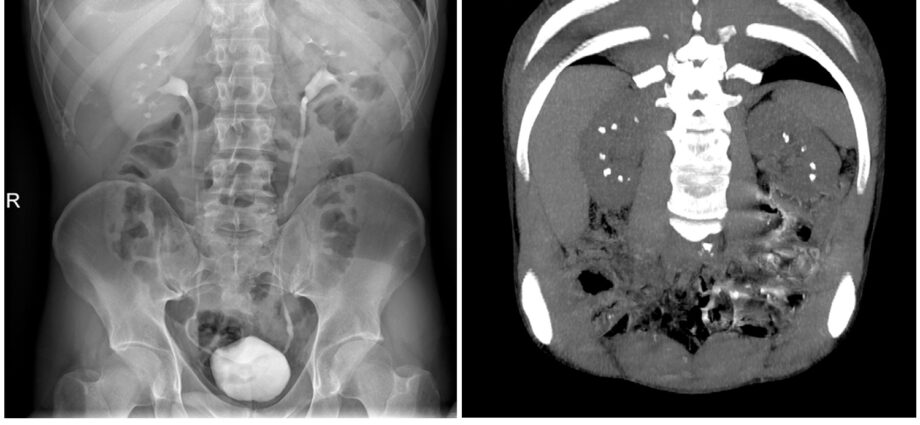Contents
The disease of Cacchi and Ricci
Cacchi and Ricci’s disease – the most common birth defect of the urinary tract – is a benign condition in itself. However, it promotes the formation of kidney stones which can cause complications such as pain and infection. There is no specific treatment.
What is Cacchi and Ricci’s disease?
Definition
Cacchi and Ricci disease is a kidney disease characterized by the dilation of the renal collecting tubes, small ducts located at the end of the nephron (functional unit of the kidney), upstream of the renal cavities called calyces. This condition, also called congenital tubular ectasia, is commonly referred to as sponge kidney or sponge medullary kidney because of the appearance of the kidneys.
Both kidneys are affected in 70% of cases.
Frequently, this condition is mild and has no consequences. But it can be accompanied by metabolic abnormalities leading to the formation of calcium oxalate kidney stones (calcium oxalate renal lithiasis). Their migration into the renal cavities can be the cause of various complications.
Causes
This pathology is due to a congenital anomaly of the kidneys, sometimes in a family context.
Diagnostic
Cacchi and Ricci disease is often found in people in their second or third decade, when kidney stones are suspected, following intravenous urography. This radiological examination allows the kidneys and the urinary tract to be explored after opacification by intravenous injection of an iodine-based X-ray opaque contrast product. It is more and more often replaced by a CT scan, which has become the reference examination.
In 30 to 50% of patients, the laboratory results reveal metabolic abnormalities. The excretion of calcium in the urine may be abnormally high (hypercalciuria), and that of citric acid lower than normal (hypocitraturia).
In patients with a mild form of the disease without renal lithiasis, the diagnosis may be made incidentally. But more often than not, the malformation will go unnoticed.
The people concerned
Cacchi and Ricci’s disease is the most common congenital malformation of the urinary tract. The frequent absence of symptoms makes it difficult to assess the number of cases, and estimates are sometimes contradictory. A study has shown that Maghreb subjects are much more rarely affected, which suggests variations according to ethnic groups.
This condition is responsible for 12 to 20% of renal lithiasis of the oxalo-calcium type, with a clear predominance of women.
Risk factors
Cacchi and Ricci disease may be associated with other malformations such as Ehlers-Danlos syndrome, congenital hemihypertrophy, Beckwith-Wiedemann syndrome or Caroli syndrome, suggesting the involvement of genetic determinants .
Symptoms of Cacchi and Ricci disease
Renal colic
When stones get blocked in the urinary tract, their obstruction results in renal colic, which manifests as sharp pain in the lumbar region.
Urinary tract infections
Stagnation of urine upstream of the excretory tract can cause a urinary tract infection, which induces a burning sensation sometimes accompanied by fever. Infection can be an inaugural sign of a pathology hitherto ignored. In complicated forms, repeated infections are frequent.
Haematuria
The loss of blood in the urine, observed at the micro- or macroscopic level, is also frequently reported as one of the first signs guiding the diagnosis.
Other symptoms
- Chronic pain
- Complications of repeat treatments
- Possible progression to nephrocalcinosis (deposit of small microscopic calcifications in the kidney tissue, causing an emission of very abundant urine) and to chronic renal failure
Treatments for Cacchi and Ricchi disease
In the absence of specific treatment for Cacchi and Ricci’s disease, management is based on conventional therapeutic means used to treat renal lithiasis and their complications.
Management of renal colic
In people suffering from simple renal colic, medical treatment is carried out on an outpatient basis and is primarily aimed at relieving pain. Nonsteroidal anti-inflammatory drugs (NSAIDs) are the standard treatment.
Analgesics (paracetamol or morphine in case of severe pain) or antispasmodics can be prescribed in combination with NSAIDs, or replace them if necessary.
Infectious manifestations must be monitored and require antibiotic treatment.
Complicated acute renal colic requires urgent hospitalization and urine drainage.
Treatment of kidney stones
Over the long term, different techniques can be used to break up kidney stones and allow their elimination. The choice depends on their location and size, but some complicated forms of the disease remain difficult to manage.
- Extracorporeal lithotripsy (or lithotripsy) uses shock waves to destroy large stones.
- Faced with kidney stones resistant to the previous technique or multiple, flexible ureterorenoscopy with laser is often preferred. It allows the lithiasis to be fragmented using a laser fiber introduced by natural means (passage through the urethra), but is contraindicated when there is diffuse lithiasis of the entire urinary tree.
- Percutaneous surgery requires intervention under general anesthesia and antibiotic treatment.
- In the most severe cases, drugs may be indicated to reduce the level of calcium oxalate, involved in the formation of most lithiasis.
Thermal cures
Spa treatments have their place as adjuvant treatment to facilitate the expulsion of stone debris and prevent recurrence of renal colic.
Prevention of lithiasis
Prevention of the formation of renal lithiasis and recurrence of renal colic is based on dietary measures. It is advisable to drink in abundance (at least two liters per day), preferably water low in calcium, to reduce the intake of animal proteins and the consumption of salt, to increase the consumption of fruits and vegetables, particularly oranges. and lemons rich in citrates, and to remove foods rich in oxalate (sorrel, spinach, cocoa…).
Depending on the composition of the stones, nutritional supplements may be useful.
Herbal medicine (plants with diruretic properties) and homeopathy can also be tried to prevent recurrence.










